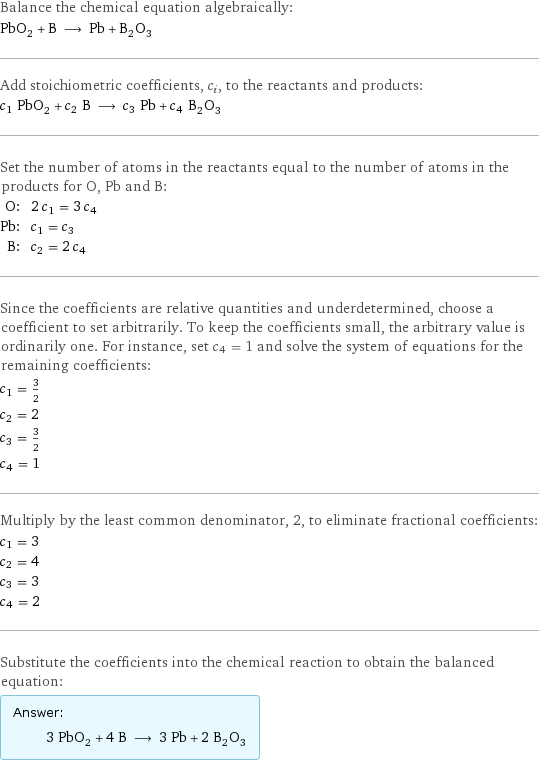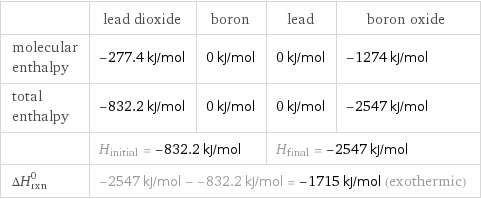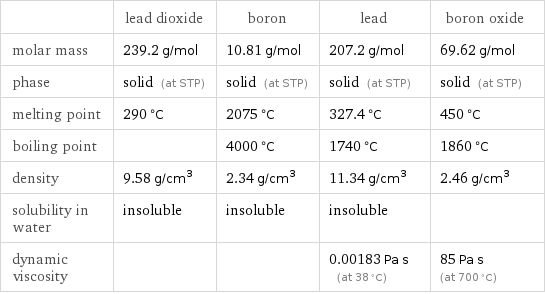Input interpretation

PbO_2 lead dioxide + B boron ⟶ Pb lead + B_2O_3 boron oxide
Balanced equation

Balance the chemical equation algebraically: PbO_2 + B ⟶ Pb + B_2O_3 Add stoichiometric coefficients, c_i, to the reactants and products: c_1 PbO_2 + c_2 B ⟶ c_3 Pb + c_4 B_2O_3 Set the number of atoms in the reactants equal to the number of atoms in the products for O, Pb and B: O: | 2 c_1 = 3 c_4 Pb: | c_1 = c_3 B: | c_2 = 2 c_4 Since the coefficients are relative quantities and underdetermined, choose a coefficient to set arbitrarily. To keep the coefficients small, the arbitrary value is ordinarily one. For instance, set c_4 = 1 and solve the system of equations for the remaining coefficients: c_1 = 3/2 c_2 = 2 c_3 = 3/2 c_4 = 1 Multiply by the least common denominator, 2, to eliminate fractional coefficients: c_1 = 3 c_2 = 4 c_3 = 3 c_4 = 2 Substitute the coefficients into the chemical reaction to obtain the balanced equation: Answer: | | 3 PbO_2 + 4 B ⟶ 3 Pb + 2 B_2O_3
Structures

+ ⟶ +
Names

lead dioxide + boron ⟶ lead + boron oxide
Reaction thermodynamics
Enthalpy

| lead dioxide | boron | lead | boron oxide molecular enthalpy | -277.4 kJ/mol | 0 kJ/mol | 0 kJ/mol | -1274 kJ/mol total enthalpy | -832.2 kJ/mol | 0 kJ/mol | 0 kJ/mol | -2547 kJ/mol | H_initial = -832.2 kJ/mol | | H_final = -2547 kJ/mol | ΔH_rxn^0 | -2547 kJ/mol - -832.2 kJ/mol = -1715 kJ/mol (exothermic) | | |
Equilibrium constant
![Construct the equilibrium constant, K, expression for: PbO_2 + B ⟶ Pb + B_2O_3 Plan: • Balance the chemical equation. • Determine the stoichiometric numbers. • Assemble the activity expression for each chemical species. • Use the activity expressions to build the equilibrium constant expression. Write the balanced chemical equation: 3 PbO_2 + 4 B ⟶ 3 Pb + 2 B_2O_3 Assign stoichiometric numbers, ν_i, using the stoichiometric coefficients, c_i, from the balanced chemical equation in the following manner: ν_i = -c_i for reactants and ν_i = c_i for products: chemical species | c_i | ν_i PbO_2 | 3 | -3 B | 4 | -4 Pb | 3 | 3 B_2O_3 | 2 | 2 Assemble the activity expressions accounting for the state of matter and ν_i: chemical species | c_i | ν_i | activity expression PbO_2 | 3 | -3 | ([PbO2])^(-3) B | 4 | -4 | ([B])^(-4) Pb | 3 | 3 | ([Pb])^3 B_2O_3 | 2 | 2 | ([B2O3])^2 The equilibrium constant symbol in the concentration basis is: K_c Mulitply the activity expressions to arrive at the K_c expression: Answer: | | K_c = ([PbO2])^(-3) ([B])^(-4) ([Pb])^3 ([B2O3])^2 = (([Pb])^3 ([B2O3])^2)/(([PbO2])^3 ([B])^4)](../image_source/7baa912ed51f9d92fdcc24c7aa661c1e.png)
Construct the equilibrium constant, K, expression for: PbO_2 + B ⟶ Pb + B_2O_3 Plan: • Balance the chemical equation. • Determine the stoichiometric numbers. • Assemble the activity expression for each chemical species. • Use the activity expressions to build the equilibrium constant expression. Write the balanced chemical equation: 3 PbO_2 + 4 B ⟶ 3 Pb + 2 B_2O_3 Assign stoichiometric numbers, ν_i, using the stoichiometric coefficients, c_i, from the balanced chemical equation in the following manner: ν_i = -c_i for reactants and ν_i = c_i for products: chemical species | c_i | ν_i PbO_2 | 3 | -3 B | 4 | -4 Pb | 3 | 3 B_2O_3 | 2 | 2 Assemble the activity expressions accounting for the state of matter and ν_i: chemical species | c_i | ν_i | activity expression PbO_2 | 3 | -3 | ([PbO2])^(-3) B | 4 | -4 | ([B])^(-4) Pb | 3 | 3 | ([Pb])^3 B_2O_3 | 2 | 2 | ([B2O3])^2 The equilibrium constant symbol in the concentration basis is: K_c Mulitply the activity expressions to arrive at the K_c expression: Answer: | | K_c = ([PbO2])^(-3) ([B])^(-4) ([Pb])^3 ([B2O3])^2 = (([Pb])^3 ([B2O3])^2)/(([PbO2])^3 ([B])^4)
Rate of reaction
![Construct the rate of reaction expression for: PbO_2 + B ⟶ Pb + B_2O_3 Plan: • Balance the chemical equation. • Determine the stoichiometric numbers. • Assemble the rate term for each chemical species. • Write the rate of reaction expression. Write the balanced chemical equation: 3 PbO_2 + 4 B ⟶ 3 Pb + 2 B_2O_3 Assign stoichiometric numbers, ν_i, using the stoichiometric coefficients, c_i, from the balanced chemical equation in the following manner: ν_i = -c_i for reactants and ν_i = c_i for products: chemical species | c_i | ν_i PbO_2 | 3 | -3 B | 4 | -4 Pb | 3 | 3 B_2O_3 | 2 | 2 The rate term for each chemical species, B_i, is 1/ν_i(Δ[B_i])/(Δt) where [B_i] is the amount concentration and t is time: chemical species | c_i | ν_i | rate term PbO_2 | 3 | -3 | -1/3 (Δ[PbO2])/(Δt) B | 4 | -4 | -1/4 (Δ[B])/(Δt) Pb | 3 | 3 | 1/3 (Δ[Pb])/(Δt) B_2O_3 | 2 | 2 | 1/2 (Δ[B2O3])/(Δt) (for infinitesimal rate of change, replace Δ with d) Set the rate terms equal to each other to arrive at the rate expression: Answer: | | rate = -1/3 (Δ[PbO2])/(Δt) = -1/4 (Δ[B])/(Δt) = 1/3 (Δ[Pb])/(Δt) = 1/2 (Δ[B2O3])/(Δt) (assuming constant volume and no accumulation of intermediates or side products)](../image_source/6ba17d31ee1fe0fb4b15c599751f7447.png)
Construct the rate of reaction expression for: PbO_2 + B ⟶ Pb + B_2O_3 Plan: • Balance the chemical equation. • Determine the stoichiometric numbers. • Assemble the rate term for each chemical species. • Write the rate of reaction expression. Write the balanced chemical equation: 3 PbO_2 + 4 B ⟶ 3 Pb + 2 B_2O_3 Assign stoichiometric numbers, ν_i, using the stoichiometric coefficients, c_i, from the balanced chemical equation in the following manner: ν_i = -c_i for reactants and ν_i = c_i for products: chemical species | c_i | ν_i PbO_2 | 3 | -3 B | 4 | -4 Pb | 3 | 3 B_2O_3 | 2 | 2 The rate term for each chemical species, B_i, is 1/ν_i(Δ[B_i])/(Δt) where [B_i] is the amount concentration and t is time: chemical species | c_i | ν_i | rate term PbO_2 | 3 | -3 | -1/3 (Δ[PbO2])/(Δt) B | 4 | -4 | -1/4 (Δ[B])/(Δt) Pb | 3 | 3 | 1/3 (Δ[Pb])/(Δt) B_2O_3 | 2 | 2 | 1/2 (Δ[B2O3])/(Δt) (for infinitesimal rate of change, replace Δ with d) Set the rate terms equal to each other to arrive at the rate expression: Answer: | | rate = -1/3 (Δ[PbO2])/(Δt) = -1/4 (Δ[B])/(Δt) = 1/3 (Δ[Pb])/(Δt) = 1/2 (Δ[B2O3])/(Δt) (assuming constant volume and no accumulation of intermediates or side products)
Chemical names and formulas

| lead dioxide | boron | lead | boron oxide formula | PbO_2 | B | Pb | B_2O_3 Hill formula | O_2Pb | B | Pb | B_2O_3 name | lead dioxide | boron | lead | boron oxide
Substance properties

| lead dioxide | boron | lead | boron oxide molar mass | 239.2 g/mol | 10.81 g/mol | 207.2 g/mol | 69.62 g/mol phase | solid (at STP) | solid (at STP) | solid (at STP) | solid (at STP) melting point | 290 °C | 2075 °C | 327.4 °C | 450 °C boiling point | | 4000 °C | 1740 °C | 1860 °C density | 9.58 g/cm^3 | 2.34 g/cm^3 | 11.34 g/cm^3 | 2.46 g/cm^3 solubility in water | insoluble | insoluble | insoluble | dynamic viscosity | | | 0.00183 Pa s (at 38 °C) | 85 Pa s (at 700 °C)
Units
